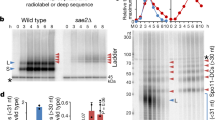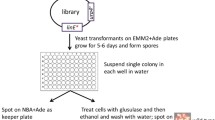Abstract
DNA double-strand breaks (DSBs) are the initiators of most meiotic recombination events. In Saccharomyces cerevisiae, at least ten genes are necessary for meiotic DSB formation. However, the molecular roles of these proteins are not clearly understood. The meiosis-specific Spo11 protein, which shows sequence similarity with a subunit of an archaeal topoisomerase, is believed to catalyze the meiotic DSB formation. Spo11 is also required for induction of meiotic DSBs at long inverted repeats and at large trinucleotide repeat tracts. Here we report the isolation and characterization of temperature-sensitive spo11-mutant alleles to better understand how Spo11 functions, and how meiotic DSBs are generated at various recombination hotspots. Analysis of mutation sites of isolated spo11-mutant alleles indicated that both N-terminal and C-terminal non-conserved residues of Spo11 are essential for the protein’s function, possibly for interaction with other meiotic DSB enzymes. Several of the mutation sites within the conserved region are predicted to lie on the surface of the protein, suggesting that this region is required for activation of the meiotic initiation complex via protein-protein interaction. In addition to the conditional mutants, we isolated partially recombination-defective mutants; analysis of one of these mutants indicated that Ski8, as observed previously, interacts with Spo11 via the latter’s C-terminal residues.



Similar content being viewed by others
References
Alani E, Padmore R, Kleckner N (1990) Analysis of wild-type and rad50 mutants of yeast suggests an intimate relationship between meiotic chromosome synapsis and recombination. Cell 61:419–436
Arora C, Kee K, Maleki S, Keeney S (2004) Antiviral protein Ski8 is a direct partner of Spo11 in meiotic DNA break formation, independent of its cytoplasmic role in RNA metabolism. Mol Cell 13:549–559
Baudat F, Manova K, Yuen JP, Jasin M, Keeney S (2000) Chromosome synapsis defects and sexually dimorphic meiotic progression in mice lacking Spo11. Mol Cell 6:989–998
Bergerat A, De Massy B, Gadelle D, Varoutas P-C, Nicolas A, Forterre P (1997) An atypical topoisomerase II from archaea with implications for meiotic recombination. Nature 386:414–417
Cadwell RC, Joyce GF (1992) Randomization of genes by PCR mutagenesis. PCR Methods Appl 2:28–33
Celerin M, Merino ST, Stone JE, Menzie AM, Zolan ME (2000) Multiple roles of Spo11 in meiotic chromosome behavior. EMBO J 19:2739–2750
Cha RS, Weiner BM, Keeney S, Dekker J, Kleckner N (2000) Progression of meiotic DNA replication is modulated by interchromosomal interaction proteins, negatively regulated by Spo11p and positively by Rec8p. Genes Dev 14:493–503
Dernburg AF, McDonald K, Moulder G, Barstead R, Dresser M, Villeneuve AM (1998) Meiotic recombination in C. elegans initiates by a conserved mechanism and is dispensable for homologous chromosome synapsis. Cell 94:387–398
Diaz RL, Alcid AD, Berger JM, Keeney S (2002) Identification of residues in yeast Spo11p critical for meiotic DNA double-strand break formation. Mol Cell Biol 22:1106–1115
Fan Q-Q, Petes TD (1996) Relationship between nuclease-hypersensitive sites and meiotic recombination hot spot activity at the HIS4 locus of Saccharomyces cerevisiae. Mol Cell Biol 16:2037–2143
Fan Q-Q, Xu F, White MA, Petes TD (1997) Competition between adjacent meiotic recombination hotspots in the yeast Saccharomyces cerevisiae. Genetics 145:661–670
Grelon M, Vezon D, Gendrot G, Pelletier G (2001) AtSPO11-1 is necessary for efficient meiotic recombination in plants. EMBO J 20:589–600
Jankowski C, Nasar F, Nag DK (2000) Meiotic instability of CAG repeat tracts occurs by double-strand break repair in yeast. Proc Natl Acad Sci USA 97:2134–2139
Jiao K, Salem L, Malone R (2003) Support for a meiotic recombination initiation complex: interactions among Rec102p, Rec104p and Spo11p. Mol Cell Biol 23:5928–5938
Kee K, Keeney S (2002) Functional interactions between SPO11 and REC102 during initiation of meiotic recombination in Sacchraomyces cerevisiae. Genetics 160:111–122
Keeney S (2001) The mechanism and control of meiotic recombination initiation. Curr Top Dev Biol 52:1–53
Keeney S, Giroux CN, Kleckner N (1997) Meiosis-specific DNA double-strand breaks are catalyzed by Spo11, a member of a widely conserved protein family. Cell 88:375–384
Kupiec M, Byers B, Esposito RE, Mitchell AP (1997) Meiosis and sporulation in Saccharomyces cerevisiae. In: Pringle J, Broach J, Jones EW (eds) The molecular and cellular biology of the yeast Saccharomyces. Cell cycle and cell biology. Cold Spring Harbor Laboratory Press, Cold Spring Harbor, pp 889–1036
Lin Y, Smith GR (1994) Transient, meiosis-induced expression of the rec6 and rec12 genes of Schizosaccharomyces pombe. Genetics 136:769–779
Louis EJ, Borts RH (2003) Meiotic recombination: too much of a good thing? Curr Biol 13:R953–R955
McKee AH, Kleckner N (1997) A general method for identifying recessive diploid-specific mutations in Saccharomyces cerevisiae, its application to the isolation of mutants blocked at intermediate stages of meiotic prophase and characterization of a new gene SAE2. Genetics 146:797–816
McKim KS, Hayashi-Hagihara A (1998) mei-W68 in Drosophila melanogaster encodes a Spo11 homolog: Evidence that the mechanism for initiating meiotic recombination is conserved. Genes Dev 12:2932–3942
Metzler-Guillemain C, deMassy B (2000) Identification and characterization of an SPO11 homolog in the mouse. Chromosoma 109:133–138
Nag DK, Kurst A (1997) A 140-base-pair long palindromic sequence induces double-strand breaks during meiosis in the yeast Saccharomyces cerevisiae. Genetics 146:835–847
Nag DK, Petes TD (1993) Physical detection of heteroduplexes during meiotic recombination in the yeast Saccharomyces cerevisiae. Mol Cell Biol 13:2324–2331
Nairz K, Klein F (1997) mre11S-a yeast mutation that blocks double-strand break processing and permits non-homologous synapsis in meiosis. Genes Dev 11:2272–2290
Nasar F, Jankowski C, Nag DK (2000) Long palindromic sequences induce double-strand breaks during meiosis in yeast. Mol Cell Biol 20:3449–3458
Neale MJ, Pan J, Keeney S (2005) Endonucleolytic processing of covalent protein-linked DNA double-strand breaks. Nature 436:1053–1057
Nichols MD, DeAngelis K, Keck JL, Berger JM (1999) Structure and function of an archaeal topoisomerase VI subunit with homology to the meiotic recombination factor Spo11. EMBO J 18:6177–6188
Ohta K, Shibata T, Nicolas A (1994) Changes in chromatin structure at recombination initiation sites during yeast meiosis. EMBO J 13:5754–5763
Paques F, Haber JE (1999) Multiple pathways of recombination induced by double-strand breaks in Saccharomyces cerevisiae. Micro Mol Biol Rev 63:349–404
Petes TD, Malone RE, Symington LS (1991) Recombination in yeast. In The molecular and cellular biology of the yeast Saccharomyces: genome dynamics, protein synthesis and energetics, vol 1 Broach JR et al. (eds) Cold Spring Harbor Laboratory, Cold Spring harbor
Prieler S, Penkner A, Borde V, Klein F (2005) The control of Spo11’s interaction with meiotic recombination hotspots. Genes Dev 19:255–269
Prinz S, Amon A, Klein F (1997) Isolation of COM1, a new gene required to complete meiotic double-strand break induced recombination in S. cerevisiae. Genetics 146:781–795
Roeder GS (1997) Meiotic chromosomes: it takes two to tango. Genes Dev 11:2600–2621
Romanienko PJ, Camerini-Otero RD (1999) Cloning, characterization, and localization of mouse and human SPO11. Genomics 61:156–169
Rose MD, Winston F, Heiter P (1990) Methods in yeast genetics. Cold Spring Harbor Laboratory Press, Cold Spring Harbor
Salem L, Walter N, Malone R (1999) Suppressor analysis of the Saccharomyces cerevisiae gene REC104 reveals a genetic interaction with REC102. Genetics 151:1261–1272
Shannon M, Richardson L, Christian A, Handel MA, Thelen MP (1999) Differential gene expression of mammalian SPO11/TOP6A homologs during meiosis. FEBS Lett 462:329–334
Storlazzi A, Tesse S, Gargano S, James F, Kleckner N, Zickler D (2003) Meiotic double-strand breaks at the interface of chromosome movement, chromosome remodeling, and reductional division. Genes Dev 17:2675–2687
Symington LS (2002) Role of RAD52 epistasis group genes in homologous recombination and double-strand break repair. Micro Mol Biol Rev 66:630–670
Tsubouchi T, Ogawa H (1998) A novel mre11 mutation impairs processing of double-strand breaks of DNA during both mitosis and meiosis. Mol Cell Biol 18:260–268
Uetz P, Giot L, Cagney G, Mansfield TA, Judson RS, Knight JR, Lockshon D, Narayan V, Srinivasan M, Pochart P, Qureshiemili A, Li Y, Godwin B, Conover D, Kalbfleisch T, Vijayadamodar G, Yang MJ, Johnston M, Fields S, Rothberg JM (2000) A comprehensive analysis of protein-protein interactions in Saccharomyces cerevisiae. Nature 403:623–627
Wu T-C, Lichten M (1994) Meiosis induced double-strand break sites determined by yeast chromatin structure. Science 263:515–518
Wu T-C, Lichten M. (1995) Factors that affect the location and frequency of meiosis-induced double-strand breaks in Saccharomyces cerevisiae. Genetics 140:55–66
Xu L, Kleckner N (1995) Sequence non-specific double-strand breaks and interhomolog interactions prior to double-strand break formation at a meiotic recombination hotspot in yeast. EMBO J 14:5115–5128
Zickler D, Kleckner N (1999) Meiotic chromosomes: integrating structure and function. Ann Rev Genet 33:603–754
Acknowledgments
We thank Kathy Atcheson and Scott Keeney for generously providing plasmids used in this study. We also thank the Wadsworth Center Molecular Genetics Core Facility for sequencing the spo11-mutant alleles. Janice Pata was supported by the new investigator start-up award from Health Research Inc., Albany, NY, USA.
Author information
Authors and Affiliations
Corresponding author
Additional information
Communicated by A. Aguilera
Rights and permissions
About this article
Cite this article
Nag, D.K., Pata, J.D., Sironi, M. et al. Both conserved and non-conserved regions of Spo11 are essential for meiotic recombination initiation in yeast. Mol Genet Genomics 276, 313–321 (2006). https://doi.org/10.1007/s00438-006-0143-7
Received:
Accepted:
Published:
Issue Date:
DOI: https://doi.org/10.1007/s00438-006-0143-7




